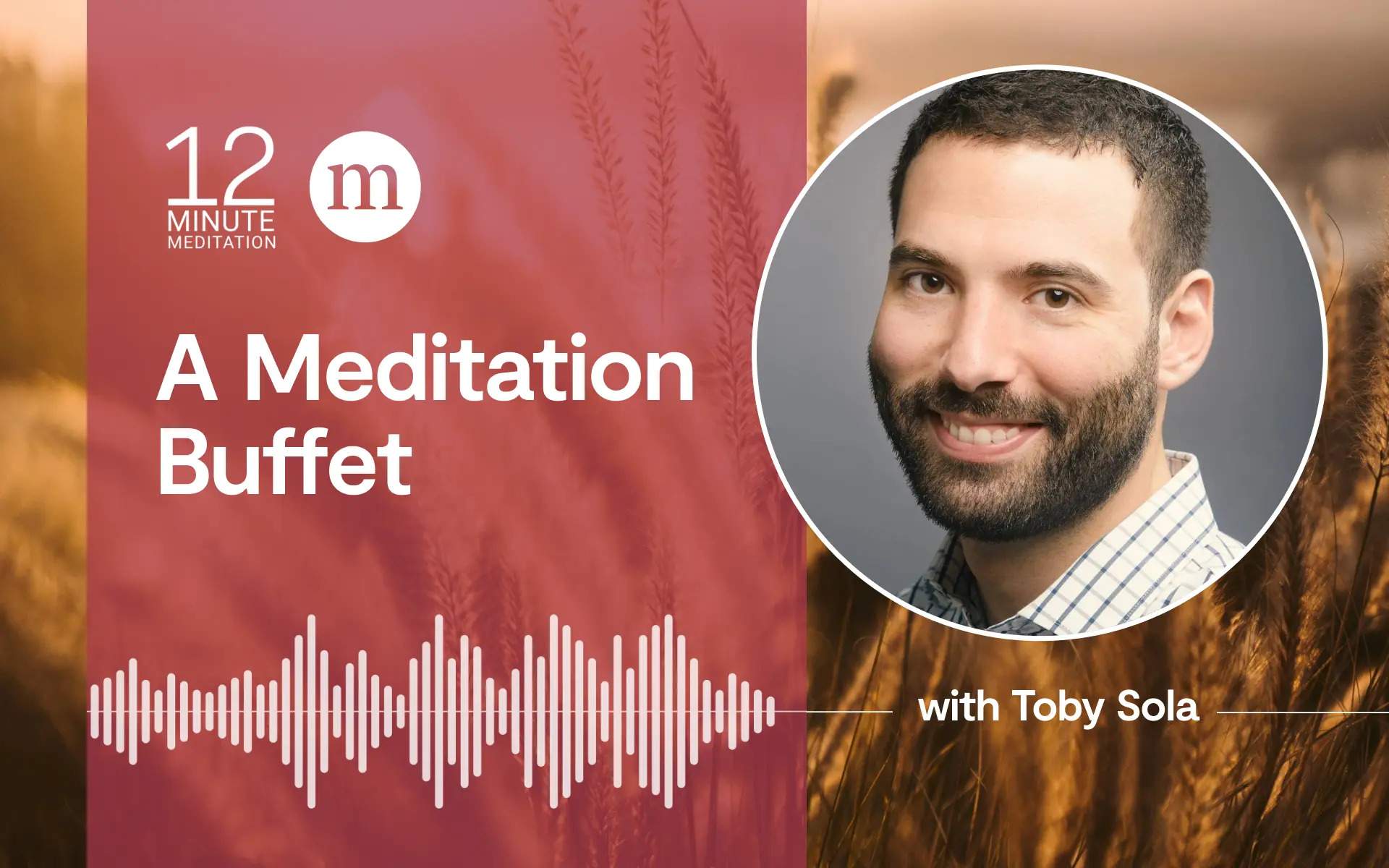Have you ever wondered why there are so many different types of meditation practices, and why some of them seem to contradict each other in approach, style, or even objective?
In today’s guided practice, meditation teacher Toby Sola walks us through three common types of meditation. Plus, he explains why the word “meditation” is very much like the word “sport”—and how all these different practices actually share the same overarching purpose.
If you’re new to meditation or curious about trying new approaches, you’ll love this week’s practice.
A Mindful Buffet: 3 Different Types of Meditation
Read and practice the guided meditation script below, pausing after each paragraph. Or listen to the audio practice.
As a meditation teacher, one of the most common questions I get goes something like this: Someone told me meditation is about focusing on your breath, but someone else told me meditation is about letting go. What gives?
The answer to this question is simple. The word meditation is like the word sport. There are a wide variety of sports, and some sports even have contradictory rules. For example, in American soccer, you’re not allowed to touch the ball with your hands. But in basketball, you are. At the same time, there is a common thread that ties together all sports. You could say all sports develop some sort of physical strength, flexibility, and skill. Meditation is exactly the same. There is a wide variety of meditation techniques, and some of them even have contradictory instructions. But all meditation techniques develop the same core skills of concentration, clarity, and balance.
In this meditation, I’ll give you a quick tour of three very different meditation techniques so you get a sense of what’s out there.
- To start, lengthen the spine. Relax the shoulders and arms. Bring your attention to what you’re hearing in your environment. Maybe you hear traffic, wind, or people talking nearby. Maybe you just hear silence. It’s all good. Just bring your attention to whatever you’re hearing.
- This type of practice is an example of a family of meditation techniques that I call “noting and labeling.” In noting and labeling techniques, you pick one or a few types of naturally occurring sensory experiences to focus on and simply redirect your attention if you get distracted.
Feel free to pause the recording and give yourself extra time to practice this technique if you like. - Next, we’re going to intentionally recite and focus on a positive word or phrase. Take a moment to think of a positive word or phrase. Here are some examples. The name of a positive emotion could be compassion or gratitude. An affirmation could sound like, I love you, keep going. Or, I am deserving of love. A statement about a positive behavior change could be something like, I go to the gym twice a week, or, I go to bed at 10 PM. These are just examples. Choose a word or phrase that you like. Once you’ve settled on a word or phrase, mentally repeat it over and over. Don’t say it out loud; say it to yourself in your mind.
- This practice is an example of a family of meditation techniques that I call “nurture positive.” In nurture positive practices, you don’t just pay attention to whatever happens to happen, like we were doing in the first part of this guidance. Instead, you intentionally create positive thoughts or feelings to focus on. Keep reciting and focusing on your phrase.
Feel free to pause the recording and give yourself extra time to practice this technique if you like. - For the third technique, we’re going to drop any kind of intentional focus. Here, you aren’t landing your attention on anything, but keeping your mind loose and unattached. If, for whatever reason, you happen to become aware of an intention to direct your attention, drop that intention. Otherwise, you don’t have to do anything.
- This is an example of a family of meditation techniques that I call “autofocus.” In autofocus practices, if you happen to become aware of an intention to control your attention, you drop that intention. Otherwise, you don’t have to do anything. Your experience may not be restful or particularly pleasant. It may not even seem like you’re practicing meditation at all, but you’re doing the technique perfectly when you just let whatever happens, happen.
Feel free to pause the recording and give yourself extra time to practice this technique if you like. - Notice how different, and even contradictory, the three exercises are. In the first exercise, we picked something to intentionally focus on, but we didn’t try to change it. In the second exercise, we created something positive to focus on. And in the third exercise, we dropped all intention to control our attention.
- This is why I say that the word meditation is like the word sport. There are a million different meditation techniques, many with contradictory instructions, but they all share the common thread of developing three core mental muscles: concentration, clarity, and balance.
The word meditation is like the word sport. There are a million different meditation techniques, many with contradictory instructions, but they all share the common thread of developing three core mental muscles: concentration, clarity, and balance.
- As we wrap up, here’s the main takeaway I want you to remember. If you’re into meditation, you’ll probably listen to all sorts of guidance. If you hear instructions that contradict what you’ve heard before, that’s not a problem. Just follow along. The teacher is simply guiding you in a unique technique that you haven’t encountered before. And that’s no big deal because all the techniques develop the same core skills. Hopefully, this realization will allow you to appreciate and learn from the wide variety of meditation techniques out there. Enjoy.






